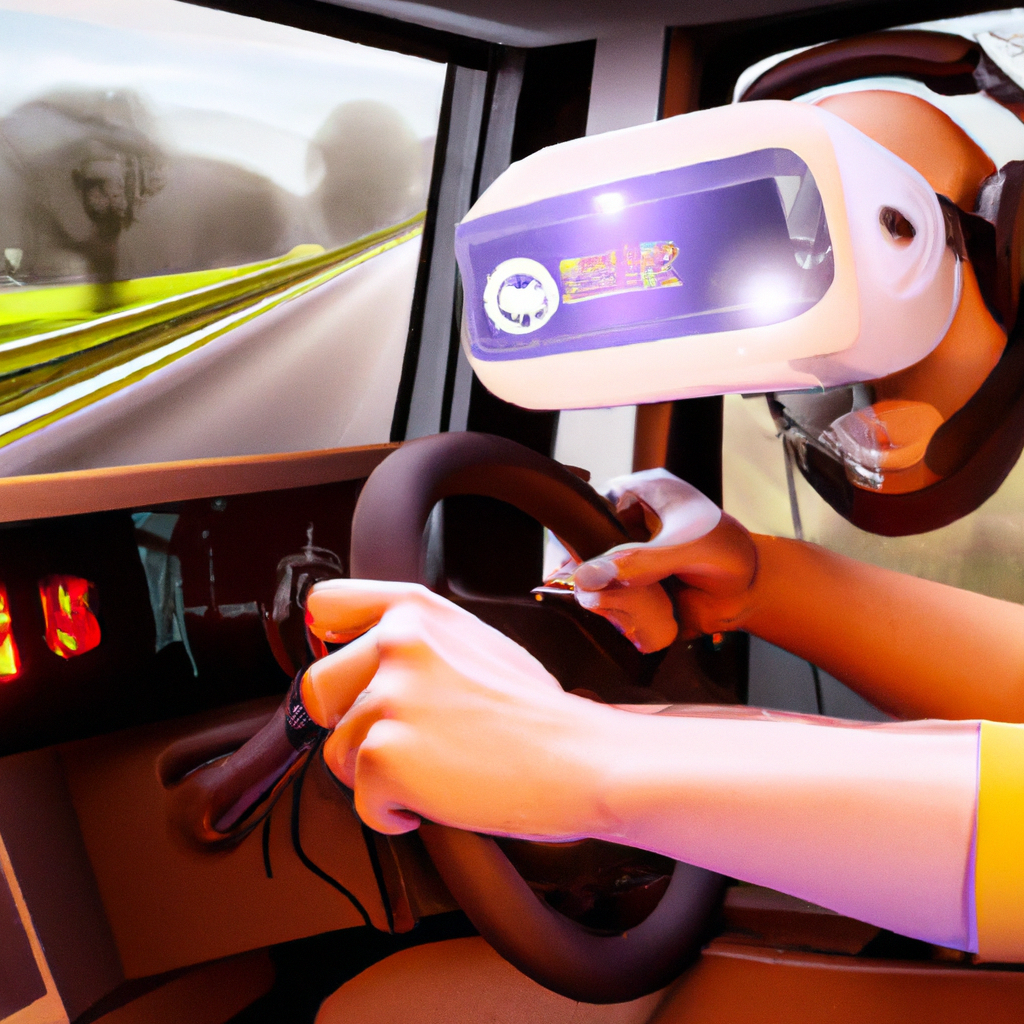작성자 정보
- dml0211 작성
- 작성일
컨텐츠 정보
- 4,816 조회
- 목록
본문

가상 현실(VR) 기술은 운송 산업에 큰 영향을 미치고 있으며, 함대 관리 및 물류를 개선할 수 있는 새롭고 혁신적인 방법을 제공합니다. 몰입적이고 상호 작용적인 환경을 만들 수 있는 능력으로, VR 기술은 운송 회사들이 그들의 함대를 더 잘 관리하고, 그들의 경로를 최적화하고, 그들의 운영의 전반적인 효율성을 향상시키는 것을 돕고 있습니다.
운송 산업에서 VR 기술의 주요 이점 중 하나는 비행대 관리를 개선할 수 있는 능력입니다. VR 시뮬레이션을 사용함으로써, 운송 회사들은 안전하고 통제된 환경에서 운전자들을 훈련시킬 수 있고, 사고의 위험을 줄이고 운전자 안전을 향상시킵니다. 이러한 유형의 VR 경험은 운송 회사가 운전자의 성능을 평가하고 개선해야 할 영역을 식별하는 데도 도움이 됩니다.
VR 기술은 비행대 관리를 개선하는 것 외에도 운송 회사가 물류 운영을 최적화하는 데도 도움이 되고 있습니다. VR 시뮬레이션을 사용함으로써, 운송 회사들은 그들의 경로를 평가하고 그들의 상품을 운송하는 데 필요한 시간과 자원을 줄이기 위해 변경할 수 있습니다. 이러한 유형의 VR 경험은 운송 회사가 탄소 배출량을 줄이고 경쟁에서 우위를 유지하는 데 도움이 됩니다.

한국에서, 운송 산업에서 VR 기술의 사용은 빠르게 성장하고 있습니다. 많은 한국 운송 회사들은 운영을 개선하고 경쟁에서 앞서기 위해 VR 기술에 투자하고 있습니다. 예를 들어, 한국의 한 선도적인 물류 회사는 직원들이 트럭의 짐을 싣는 것부터 물건의 배달에 이르기까지 상품의 운송을 시뮬레이션할 수 있는 VR 시스템을 개발했습니다. 이러한 유형의 VR 경험은 회사가 경로를 최적화하고, 제품을 운송하는 데 필요한 시간과 리소스를 줄이고, 운영의 전반적인 효율성을 개선하는 데 도움이 됩니다.
결론적으로, VR 기술은 운송 산업에 큰 영향을 미치고 있으며, 함대 관리 및 물류를 향상시킬 수 있는 새롭고 혁신적인 방법을 제공합니다. 몰입적이고 상호 작용적인 환경을 만들 수 있는 능력으로, VR 기술은 운송 회사들이 그들의 함대를 더 잘 관리하고, 그들의 경로를 최적화하고, 그들의 운영의 전반적인 효율성을 향상시키는 것을 돕고 있습니다. VR 기술이 계속 발전하고 발전함에 따라, 우리는 미래에 운송 산업에서 훨씬 더 흥미롭고 혁신적인 VR 경험을 볼 수 있을 것으로 기대할 수 있습니다.
요약하면, VR 기술은 운송 산업을 변화시키고 있으며, 함대 관리 및 물류를 개선하기 위한 새롭고 혁신적인 방법을 제공합니다. 몰입적이고 상호 작용적인 환경을 만들 수 있는 능력으로, VR 기술은 운송 회사들이 그들의 함대를 더 잘 관리하고, 그들의 경로를 최적화하고, 그들의 운영의 전반적인 효율성을 향상시키는 것을 돕고 있습니다. VR 기술이 계속 발전하고 발전함에 따라, 우리는 미래에 운송 산업에서 훨씬 더 흥미롭고 혁신적인 VR 경험을 볼 수 있을 것으로 기대할 수 있습니다.

가상 현실 기술은 함대를 관리하고 물류를 최적화하는 새로운 방법을 제공함으로써 운송 산업에 혁명을 일으킬 수 있는 잠재력을 가지고 있습니다. 운송에서 VR의 주요 이점 중 하나는 운전자 및 기타 인력에 대한 향상된 교육입니다. VR을 통해 운전자는 실제 도로 조건을 복제하는 시뮬레이션된 운전 시나리오를 경험할 수 있으며, 안전하고 통제된 환경에서 연습하고 기술을 향상시킬 수 있습니다.
또한, VR은 차량과 운전자에 대한 실시간 모니터링을 제공하여 회사가 위치, 속도 및 연료 소비량을 추적할 수 있도록 함으로써 비행대 관리를 향상시키는 데에도 사용될 수 있습니다. 이 정보는 경로를 최적화하고 연료 소비를 줄여 기업이 비용을 절감하고 탄소 배출량을 줄이는 데 사용할 수 있습니다.
물류 부문에서는 VR을 사용하여 공급망 네트워크를 시각화하고 최적화하여 기업이 운영의 병목 현상과 비효율성을 식별할 수 있도록 지원할 수 있습니다. 이는 운송 산업과 같이 복잡하고 역동적인 환경에서 운영되는 기업에 특히 유용할 수 있습니다.

한국의 운송 산업에서 VR이 사용되는 한 가지 예는 직원들을 훈련시키기 위해 VR 기술을 구현한 한국철도공사입니다. 코레일은 기관사들이 폭우와 눈 등 다양한 기상 상황을 체험하고 열차 탈선 등 비상 상황에 대처하는 연습을 할 수 있는 VR 시뮬레이션 시스템을 개발했습니다. 이는 코레일 운영의 안전과 효율성 향상에 도움이 되었으며, 직원과 승객 모두에게 좋은 반응을 얻고 있습니다.
결론적으로, 운송 산업에서 가상 현실을 사용하는 것은 비행대 관리, 물류 및 훈련에서 상당한 개선을 가져올 수 있는 잠재력을 가지고 있습니다. VR은 실시간 모니터링, 향상된 교육 기회 및 시각화 도구를 제공함으로써 운송 업계의 기업들이 운영을 최적화하고 비용을 절감하며 안전성을 개선하도록 돕고 있습니다.
Virtual reality (VR) technology is having a major impact on the transportation industry, offering new and innovative ways to enhance fleet management and logistics. With its ability to create immersive and interactive environments, VR technology is helping transportation companies to better manage their fleets, optimize their routes, and improve the overall efficiency of their operations.
One of the key benefits of VR technology in the transportation industry is its ability to improve fleet management. By using VR simulations, transportation companies can train their drivers in a safe and controlled environment, reducing the risk of accidents and improving driver safety. This type of VR experience is also helping transportation companies to evaluate the performance of their drivers, and to identify areas for improvement.
In addition to improving fleet management, VR technology is also helping transportation companies to optimize their logistics operations. By using VR simulations, transportation companies can evaluate their routes and make changes to reduce the time and resources required to transport their goods. This type of VR experience is helping transportation companies to reduce their carbon footprint and to stay ahead of the competition.
In Korea, the use of VR technology in the transportation industry is growing rapidly. Many Korean transportation companies are investing in VR technology to improve their operations, and to stay ahead of the competition. For example, a leading Korean logistics company has developed a VR system that allows employees to simulate the transportation of goods, from the loading of the truck to the delivery of the goods. This type of VR experience is helping the company to optimize its routes, reduce the time and resources required to transport its goods, and improve the overall efficiency of its operations.
In conclusion, VR technology is having a major impact on the transportation industry, offering new and innovative ways to enhance fleet management and logistics. With its ability to create immersive and interactive environments, VR technology is helping transportation companies to better manage their fleets, optimize their routes, and improve the overall efficiency of their operations. As VR technology continues to evolve and improve, we can expect to see even more exciting and innovative VR experiences in the transportation industry in the future.
In summary, VR technology is transforming the transportation industry, offering new and innovative ways to enhance fleet management and logistics. With its ability to create immersive and interactive environments, VR technology is helping transportation companies to better manage their fleets, optimize their routes, and improve the overall efficiency of their operations. As VR technology continues to evolve and improve, we can expect to see even more exciting and innovative VR experiences in the transportation industry in the future.
Virtual reality technology has the potential to revolutionize the transportation industry by offering new ways to manage fleets and optimize logistics. One of the key benefits of VR in transportation is improved training for drivers and other personnel. With VR, drivers can experience simulated driving scenarios that replicate real-life road conditions, allowing them to practice and improve their skills in a safe and controlled environment.
In addition, VR can also be used to enhance fleet management by providing real-time monitoring of vehicles and drivers, allowing companies to track their location, speed, and fuel consumption. This information can be used to optimize routes and reduce fuel consumption, helping companies to save money and reduce their carbon footprint.
In the logistics sector, VR can be used to visualize and optimize supply chain networks, helping companies to identify bottlenecks and inefficiencies in their operations. This can be especially useful for companies that operate in complex and dynamic environments, such as those in the transportation industry.
One example of VR being used in the transportation industry in Korea is the Korea Railroad Corporation (KORAIL), which has implemented VR technology to train its employees. KORAIL has developed a VR simulation system that allows train drivers to experience various weather conditions, such as heavy rain and snow, and to practice handling emergency situations, such as train derailments. This has helped to improve the safety and efficiency of KORAIL's operations, and has been well received by both employees and passengers.
In conclusion, the use of virtual reality in the transportation industry has the potential to bring about significant improvements in fleet management, logistics, and training. By providing real-time monitoring, enhanced training opportunities, and visualization tools, VR is helping companies in the transportation industry to optimize their operations, reduce costs, and improve safety.







